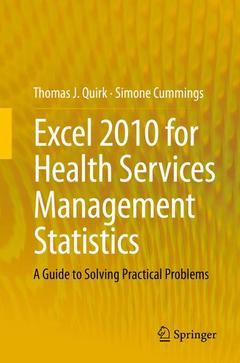Description
Excel 2010 for Health Services Management Statistics, 2014
A Guide to Solving Practical Problems
Language: English
Subjects for Excel 2010 for Health Services Management Statistics:
Keywords
Applied Health Services Management Statistics; Excel 2010 Health Services Management Statistics; Excel Statistics; Health Services Management Statistics; Health Services Management Statistics a first course; Health Services Management Statistics with Excel 2010; Learn Statistics with Excel; Practical Health Services Management Statistics; Statistics Health Management; Statistics for Health Services
254 p. · 15.5x23.5 cm · Paperback
Description
/li>Contents
/li>Biography
/li>Comment
/li>
Excel, a widely available computer program for students and managers, is also an effective teaching and learning tool for quantitative analyses in health services management courses. Its powerful computational ability and graphical functions make learning statistics much easier than in years past. However, Excel 2010 for Health Services Management Statistics: A Guide to Solving Practical Problems is the first book to capitalize on these improvements by teaching students and managers how to apply Excel to statistical techniques necessary in their courses and work.
Each chapter explains statistical formulas and directs the reader to use Excel commands to solve specific, easy-to-understand health services management problems. Practice problems are provided at the end of each chapter with their solutions in an Appendix. Separately, there is a full Practice Test (with answers in an Appendix) that allows readers to test what they have learned.
At the beginning of his academic career, Prof. Quirk spent six years in educational research at The American Institutes for Research and Educational Testing Service. He then taught Social Psychology, Educational Psychology, General Psychology, Marketing, Management, and Accounting at Principia College, and is currently a Professor of Marketing in the George Herbert Walker School of Business & Technology at Webster University based in St. Louis, Missouri (USA) where he teaches Marketing Statistics, Marketing Research, and Pricing Strategies. He has written 60+ textbook supplements in Marketing and Management, published 20+ articles in professional journals, and presented 20+ papers at professional meetings. He holds a B.S. in Mathematics from John Carroll University, both an M.A. in Education and a Ph.D. in Educational Psychology from Stanford University, and an M.B.A. from The University of Missouri-St. Louis.
Prior to receiving her doctorate, Prof. Cummings worked for several hospitals including Barnes-Jewish Hospital, Children's Hospital, and St. Louis Regional Hospital, all in St. Louis, Missouri (USA), as well as Columbia Hospital for Women in Washington, D.C. She began her academic career in the Health Care Administration program at Simmons College in Boston and later taught in the Health Administration Program at Washington University in St. Louis. Prof. Cummings is currently an Associate Professor of Healthcare Management in the George Herbert Walker School of Business & Technology at Webster University in St. Louis, Missouri where she teaches Statistics for Healthcare Management and Healthcare Finance. She holds a B.S. in Business Administration from the Olin School of Business at Washington University in St. Louis, an M.H.A. from the Washington University School of Medicine, and a Ph.D. in Health Policy and Administration from the Gillings School of Public Health at the University of North Carolina ChapelHill. Prof. Cummi




